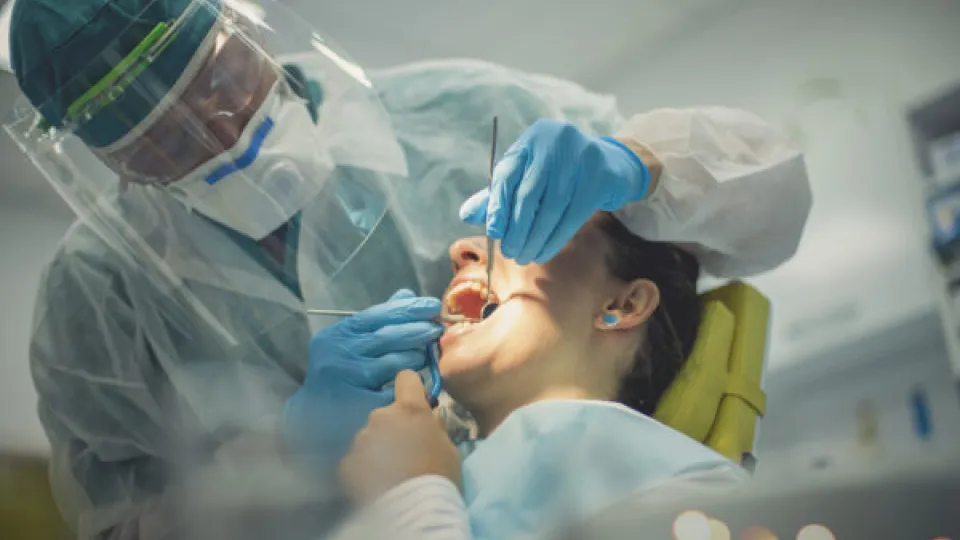
A 2014 study from the American Dental Association (ADA) found that most dental-related emergency room visits are semiurgent or nonurgent (1). Researchers found that dental offices could better handle these cases. Treating these emergencies in dental offices is better for patients and the health care system. Discover why it's so important to keep dental emergencies away from emergency rooms.
Types of Dental Emergencies
Before examining why dental emergencies should stay out of emergency rooms, you should understand what defines a dental emergency. Dental emergencies are acute problems that involve the mouth or teeth, including bleeding, infections, and swelling. With these dental emergencies, patients can experience intense pain. Additionally, dental health problems can also put teeth and gums at risk. Some common dental emergencies can occur after injuries, such as knocked-out teeth, teeth chips, fractures, and soft tissue trauma and bleeding. Other dental emergencies, such as acute toothache and abscesses, may result from chronic conditions.
Dental emergencies may be urgent or nonurgent. Based on triage status, more patients presenting dental emergencies had semiurgent or nonurgent dental needs than people with nondental concerns (1).
If the problem can wait for a dentist appointment, it is a nonurgent dental emergency. A chipped tooth causing no pain is an example of a severe but nonurgent dental emergency. However, if the chipped tooth is very painful or chips of the tooth are causing trauma in the mouth, this case could be an urgent dental emergency worth visiting the ER. As a rule, if a dental emergency impacts swallowing or breathing, it is a critical dental emergency. Patients should attempt to see their dentist for these issues but may visit an ER if they cannot visit a dentist.
The ER may also be the best choice for patients who sustain injuries to the mouth. An ER doctor can verify that a patient didn't fracture or dislocate the jaw. A medical professional can also examine lacerations and clean them thoroughly to make sure they don't become infected. ER doctors can also assess swelling to ensure it won't impact breathing if the swelling becomes worse.
Keeping Dental Emergencies Out of the ER Relieves Pressure on Hospitals
Emergency rooms are increasingly under pressure. Dealing with dental emergencies in dental offices, rather than ERs, is one effective way to lighten the load. Dental-related visits to emergency departments are increasing, according to the ADA Health Policy Resources Center. Looking at historical data, the center stated that 2.1 million Americans visited an ER for dental problems in 2010, compared to 1.1 million in 2000 (2).
Treating more of these patients in dental offices would reduce pressure on ER doctors and nurses. These medical professionals could treat other patients faster and more effectively. This arrangement is good news for patients, too, as it leaves hospital beds in emergency rooms for people with medical emergencies.
Reducing pressure on emergency departments is always essential. However, it's more vital during the global COVID-19 pandemic. During this time, ER doctors in many parts of the country face medical supply and personal protective equipment shortages. Dealing with dental emergencies outside the ER saves these essential resources for medical professionals who need them.
Keeping Dental Emergencies Out of the ER Saves Money
The ADA estimates treating dental emergencies in dental offices, rather than ERs, could save Americans up to $1.7 billion every year (1). These savings could help patients afford health insurance, Medicaid premiums, and preventive dental visits.
Sadly, many people who visit ERs for dental emergencies are people without health insurance and others with limited finances (2). Financial concerns may have kept these individuals away from dentists. In turn, they miss preventive treatments, such as cleaning and scaling, that can prevent dental emergencies from occurring in the first place.
By trying to save money on dental checkups, these patients often face ER bills as expensive as several years of dental visits. Many dentists will treat patients with or without health insurance for less than they'd spend at the ER. For example, Colgate notes that ER patients can pay nearly 10 times more for a tooth extraction than they would at their dentists' offices (3). Many ER doctors will also refer patients with dental emergencies to dentists for follow-up treatment, which can further add to the financial pain.
Patients Receive Continuity of Care When They Visit Their Dentist
Visiting a dental office, instead of an emergency room, for dental emergencies gives patients continuity of care. They can see their regular dentist, who understands their oral history, instead of someone who must come up to speed in a much shorter period. According to the Australian Dental Association, dentists familiar with their patients' histories can make the most informed choices about ongoing treatment methods (4). This approach provides the best care and patient outcomes over time.
Visiting a dental office also provides more continuous care than visiting the ER, where doctors may refer you to a dentist for follow-up care. When you visit a dental office in the first instance, you can get all the care you need in one place.
Patients also tend to trust their regular dentists since they have had time to build relationships with them. They would not continue to return year after year without trusting their dentist. Emergency practitioners must try to establish a rapport quickly, which is much more difficult. When patients feel more relaxed, they typically have a better experience in care.
Dentists Are More Equipped to Handle Dental Emergencies
While ERs are well-established to manage acute general health complaints, they don't always have equipment and tools for treating dental emergencies. Many emergency rooms also don't have dentists on call. Only dentists can perform dentistry procedures, such as filling cavities and extracting teeth.
Without the correct equipment and tools on hand or people with specialist dental training, ER practitioners are unlikely to give patients who have emergency dental problems the best care. These individuals can stem bleeding and treat any broken bones around the mouth. However, they will only prescribe painkillers to numb pain and antibiotics for oral infections in most cases. After completing their course of treatment, many patients return to the ER with the same dental emergencies. Often the problem is worse the second time around due to delayed treatment.
In contrast, dentists have specialist training and tools that help them treat the underlying cause of dental emergencies. Cutting-edge equipment, including intraoral cameras and cone-beam scanners, help them accurately diagnose dental problems. They can also access nitrous oxide and oral conscious sedation to reduce pain and anxiety for patients. In many cases, patients eventually need to visit their dentists for more permanent solutions to their problems, so visiting them first makes sense.
"I don't think a lot of people realize emergency rooms are not equipped to handle dental emergencies," Dr. Marvin Berlin, a McKinney dentist, told a Dallas television station, WFAA-TV (5).
Often patients would receive better treatment if they visited a dental office initially. While this approach can be challenging when accidents occur outside regular business hours, many dental practices have extended hours to provide emergency care to their patients. Even if one of these clinics isn't available, some patients may have better outcomes if they waited until their regular dentist was available, especially if their problem is nonurgent or only semiurgent.
Patients Can Often See Their Dentists Faster Than ER Doctors
As emergency departments treat a range of medical emergencies, wait times are often long. According to the Harvard Business Review, the average ER patient waits more than 90 minutes before entering an exam room (6). The average time between arrival and discharge is more than two hours. In some parts of the country, the wait is much longer. In some busy urban areas, dental problems are such low priorities that staff members dismiss patients from the ER before seeing a doctor.
With 30.5% of patients with emergency dental concerns visiting their local ER during regular business hours (1), and many others visiting during hours when local dentists may have extended hours, many people could see their dentists more quickly. Dentist offices only handle issues concerning the mouth, so they're usually far quieter than ERs. Many dental offices prioritize patients needing emergency care. They may reorganize appointments or stay open longer to ensure these patients get the treatment they need when they need it.
Waiting times are likely to be shorter during the pandemic when many dental offices have suspended elective and nonurgent procedures. The majority of these practices are still accepting emergency dental cases. Since these dentists may not treat as many patients who need routine checkups or other services, such as teeth whitening, patients with dental emergencies aren't likely to wait long for treatment.
Keeping Emergency Dental Patients Out of ERsReduces Their Risk of Exposure to Illnesses
Emergency departments attract patients with a host of health complaints, including infectious diseases. When people with emergency dental complaints visit ERs, they potentially expose themselves to these illnesses. For example, they can never feel entirely confident why the person sitting next to them in triage is visiting. This situation is especially concerning during the global COVID-19 pandemic when many people who are visiting hospital ERs test positive for the deadly coronavirus. Even outside the pandemic, ER patients are at risk of catching colds and other viruses.
Dental offices are relatively safe environments since they have fewer people in their waiting rooms. Patients also visit for dental concerns, which are not as contagious as illnesses in emergency rooms. Many dentist offices have also stepped up their cleaning practices since the global coronavirus pandemic began. Dental offices across the country are regularly sterilized and cleaned following Centers for Disease Control and Prevention guidelines to further their patients' peace of mind. They also operate with only essential personnel, which further reduces the risk of exposure.
Dentists also see their patients much more quickly than ER doctors. Less waiting time further reduces the risk of contracting an illness. These practices make visiting a dental office, instead of an ER, a much lower-risk activity and an effective way to keep dental patients safe.
Emergency Departments Can't Provide Follow-Up Care
Emergency departments treat patients in the hospital setting itself and send them on their way. In contrast, dental offices focus on helping patients achieve long-term oral health. Unlike emergency departments, they have the resources to provide ongoing follow-up care.
Dental professionals recommend follow-up appointments after emergency dental problems occur. Dentists want to see how their patients are healing and devise treatment plans if issues persist. They may also suggest strategies that can help their patients reduce the risk of further emergency dental problems. Patients who visit the ER and then don't follow up with a dentist may have underlying issues that could cause more severe problems in the future.
Patients may need to visit the ER when they cannot see their dentists and are experiencing severe dental issues that impact swallowing or breathing. ERs are also better equipped to deal with jaw injuries. However, all dentists should try to keep dental emergencies out of the ER. Encouraging routine dentist visits and providing preventive care are some of the best ways to prevent dental emergencies from occurring and impacting ERs.
Learn more about preventive dentistry and emergency care through a dental assistant program at Concorde. Visit our website to learn more about studying with us or apply to a Concorde campus near you.
Footnotes
- "Majority of Dental-Related Emergency Department Visits Lack Urgency and Can Be Diverted to Dental Offices," American Dental Association, https://www.ada.org/~/media/ADA/Science%20and%20Research/HPI/Files/HPIBrief_0814_1.ashx
- "From the Emergency Room to the Dental Chair," American Dental Association, https://www.ada.org/en/public-programs/action-for-dental-health/er-referral
- "Seeking Treatment for Oral Care Problems in Emergency Rooms," Colgate, https://www.colgate.com/en-us/oral-health/dental-emergencies-and-sports-safety/seeking-treatment-for-oral-care-problems-in-emergency-rooms
- "Your Dentist, Your Choice: The Importance of Continuity of Care," Australian Dental Association, https://www.vcdental.com.au/wp-content/uploads/2020/01/Your-Dentist-Your-Choice-The-importance-of-continuity-of-care-ADA.pdf
- "Have a Dental Emergency? Dentists Say Call Them First, Instead of Going to the ER," WFAA, https://www.wfaa.com/article/news/health/have-a-dental-emergency-dentists-say-call-them-first-instead-of-going-to-the-er/287-b38d1702-77be-4917-b77a-1af350b2add0
- "To Reduce Emergency Room Wait Times, Tie Them to Payments," Harvard Business Review, https://hbr.org/2019/02/to-reduce-emergency-room-wait-times-tie-them-to-payments
- "Image," LukaTDB, https://www.istockphoto.com/portfolio/lukatdb?assettype=image&mediatype=photography
Take The Next Step Towards a Brighter Future
We have a Concorde representative ready to talk about what matters most to you. Get answers about start dates, curriculum, financial aid, scholarships and more!




